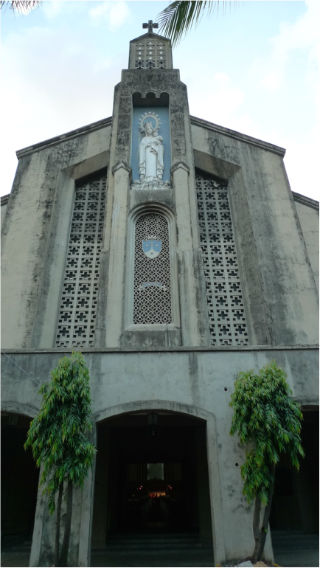Filtered By: Lifestyle
Lifestyle
Mt. Carmel Shrine now a pilgrimage church, Pandacan church marks 300 years
Many Filipinos who are devout Catholics make it a point to visit sacred places all over the country, such as the Shrine of Our Lady of Manaoag in Pangasinan, the Basilica Minore del Santo Niño in Cebu, Shrine of Our Lady of Peace and Good Voyage in Antipolo, Rizal, the Peñafrancia Basilica Minore in Naga, or the Basilica of Our Lady of Piat, which is considered the pilgrimage center of Cagayan Valley.
Around 81 percent of Filipinos are Catholic, and while many are able to observe practices such as Sunday Mass, fewer can afford to go on pilgrimages.
Going on a pilgrimage can be difficult, as it requires time and money, depending on how far the pilgrimage site is.
Fortunately, there are options even in Manila, such as Quiapo Church, which is filled with countless devotees on the Feast of the Nazarene, and Baclaran Church, where religious devotees gather every Wednesday.
Mt. Carmel Shrine

Mt. Carmel Shrine in New Manila Photo from Mt. Carmel Shrine
Just last week, the Mount Carmel Shrine Parish in New Manila, Quezon City was declared a pilgrimage church for the Year of Faith, the Catholic Bishops' Conference of the Philippines said over the weekend. The Year of Faith begins on October 11, 2012 and ends on November 24, 2013.
Cubao Bishop Honesto Ongtioco's designation of the shrine will give Catholics who do not have the time or funds for a pilgrimage a more accessible alternative, the CBCP said.
"(A)s such, pilgrims may gain a plenary indulgence by visiting the church and going on a ‘spiritual journey’ on their own," the CBCP said on its news site Sunday.
The CBCP said a plenary indulgence “removes all temporal punishment due for sins," whether "in this life, in the form of various sufferings, or in the next life, in purgatory.”
Assistant parish priest Fr. Ransom Rapirap suggested that people may want to “take part in some sacred function" or pause for recollection with meditations. Such meditations may end with the recitation of the "Our Father," the profession of Faith, invocations to the Blessed Virgin Mary and even Holy Apostles or Patrons, Rapirap said.
Rapirap noted a plenary indulgence requires the person to be in the state of grace, have complete detachment from sin, and pray for the Holy Father’s intentions.
An individual must also receive Reconciliation (confession) and receive Communion up to about 20 days before or after completing the other acts, the CBCP noted.
People unable to go to the church due to physical illness may still obtain the indulgence by praying an "Our Father," the Profession of Faith and other prayers along the lines of the objectives of the Year of Faith, the CBCP said.
Pandacan church marks 300 years
Another occasion for Catholics to gain plenary indulgence is the opening of the Jubilee Door of the Church, a highlight of this week's celebrations as Sto. Niño de Pandacan Parish marks its 300th anniversary as a parish church.
Manila Auxiliary Bishop Broderick Pabillo will lead a Mass during the opening of the Jubilee Door, which will be on Nov. 23. The celebrations begin with a “PandaCandle” lighting ceremony at around 9:25 p.m. of Nov. 23. Sirens blaring from the oil depots will signal Pandacan's faithful to gather with their lighted candles, CBCP also said.
"While holding a lighted Tercentennial candle, the youth will make a human formation of 'Pandacan 300' and the hermanos and hermanas of each barangay will place a torch in a specially constructed stand," they said.
On Nov. 24, a contingent from 29 Pandacan barangays will perform the Grand Buling-Buling street dance at the Church patio, the report also said. While the Buling-Buling is the official cultural dance of the City of Manila, organizers said this is more than a dance, but a prayer within the dance. According to them, the steps and gestures denote worship, praise, contrition, gratitude and supplication.
The CBCP said dignitaries, guests, clergy, and around 1,000 youths are expected to attend the opening celebration. The best performers will receive awards which named after three theological virtues, the core of the parish tercentennial celebration: Gawad Pag-ibig, Gawad Pananampalataya, and Gawad Pag-asa, the report said.
A blessing and lighting of the tercentennial tree, a narra at the patio of the Church will also be held in the evening of Nov. 24.
The two-day celebration, with the theme “Sto. Niño de Pandacan Parish: 300 Years of Faith, Hope, and Love,” will be livestreamed at www.stoninodepandacan.com.
According to CBCP, children playing in a field near a carabao wallow surrounded by pandan plants found the miraculous black image of the Santo Niño (Christ Child) in the early 1600s. The place was originally called Pandanan, which means "pandan plantation." The name was changed because the Spaniards mispronounced it as Pandacan, they said.
Santo Niño de Pandacan became a parish on November 23, 1712 with Fr. Diego de Villalba, a Franciscan friar, as the first parish priest, CBCP said. –Carmela G. Lapeña/KG, GMA News
More Videos
Most Popular




